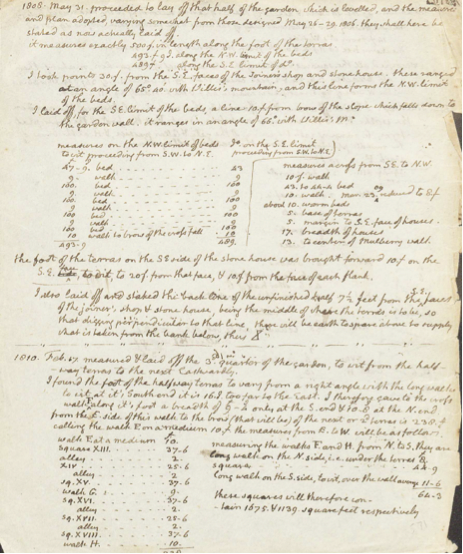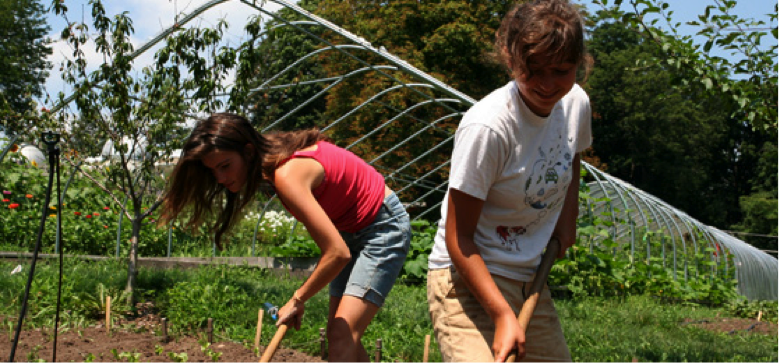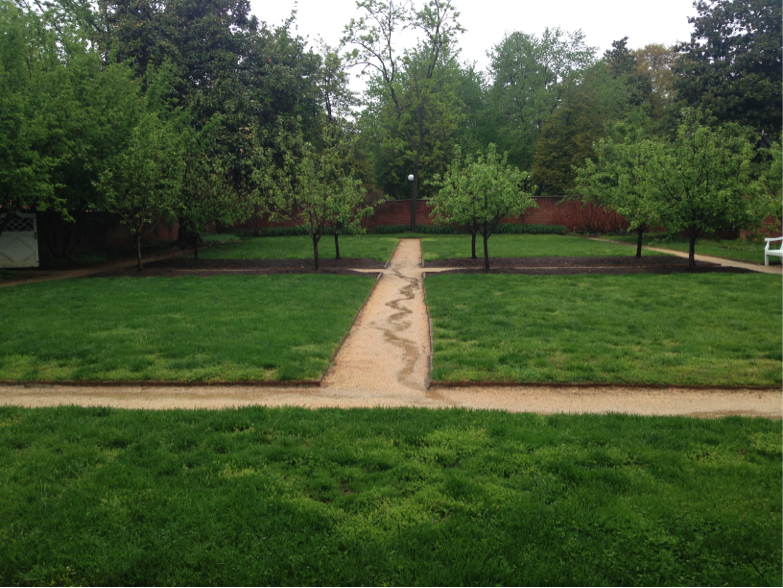As the Edible Tree & Shrub team’s previous blog posts have pointed out, there is a unique combination of Jeffersonian history and “foodie” interests that coincides at UVA, especially in the Pavilion Gardens. While these spaces currently stand-out primarily in their botanical purpose, which is useful for garden parties and ceremonies, and a quiet place to study, the edible nature of these spaces has the potential to highlight their utilitarian history and serve as places for engaged and hands-on learning. It is with this in mind that the quantity and quality of edible trees and shrubs on-grounds could be enhanced to better facilitate our connectedness to the nature around us.
From his letters and notes about UVA grounds, the Pavilion Gardens, and his intentions for a school of botany, it is clear that Thomas Jefferson fully intended for the students of his University to obtain as deep and fundamental an appreciation for and understanding of gardening and agriculture as any other science, such as chemistry. His belief that “cultivators of the earth” are the “most vigorous, the most independent, the most virtuous” compelled him to stress that the University experience be rounded out with knowledge of the tended natural world, and his plans thoroughly indicate that this may have occurred in these kinds of “educational landscapes.”

Although we have since moved away from that vision, models of educational landscapes based on edible foods and shrubs highlight the capacity for us to respect Jefferson’s ideas. For example, apart from providing a local source of ingredients for university dining halls, the Yale Sustainable Food Project includes a large educational component that fosters “exploration and academic inquiry into food and agriculture.” Numerous conferences, weekly lecture event series, and hands-on programs allow students to learn about sustainable agriculture and its relation to the environment, health, politics, and the global economy. Its growth has led to the introduction of a sustainable agriculture concentration in Yale’s forestry school. This use of edible landscaping for educational purposes is also seen at schools such as Vassar, Wellesley, and Virginia Tech.

I recently had the opportunity to sit down with Professor of Landscape Architecture Nancy Takahashi to discuss this concept during research for another planning class. She emphasized that by highlighting the existing edible trees and shrubs at UVA, and adding to them in spaces such as Nameless Field that were originally intended for cultivation purposes, the University would promote the establishment of spaces that educate people, so that we may “learn & be inspired from our surroundings.” By adding to the existing food gardens that are associated with dining halls (e.g. Hereford is associated with Runk, the student garden is associated with OHill), there is opportunity to extend this to central grounds in historically-relevant manners. The Pavilion 9 garden, which currently features orchard-style landscaping and vast expanses of monoculture grass, could be used a garden for West Range Café to source food locally. A part of nameless field could similarly be designated to work with Newcomb Dining hall. The University could in turn institutionalize the academic nature of such places by affiliating them with the existing Global Sustainability minor or by creating a garden-based USEM, and by promoting STEM learning and experimentation in these spaces. Additionally, by emphasizing Jefferson’s intentions for cultivated places on-grounds, there is great potential to expand opportunities for learning about UVa’s history.

Although, as mentioned in earlier posts, it is implausible to fully amend for the great environmental costs of dining halls by localizing food sources entirely, the sustainability role of merely demonstrative on-grounds gardens is still great. Using the Pavilion gardens as demonstrative food spaces could serve to exemplify how local food sources address environmental concerns in each of these realms. Among the environmental solutions that could be demonstrated are the use of dining hall compost as fertilizer, rainwater collection for watering, the cultivation of native produce, etc. The presence of this garden as a model for attainable and everyday green practices could encourage and solidify eco-conscious mindsets in the University community, and in turn, students might adopt more environmentally-friendly habits, passively helping the University to meet its sustainability goals.
The edible plants that exist at U.Va speak to Jefferson’s agrarian character and parallel the Charlottesville’s place as the “local food capital of the world.” There is great potential to increase the visibility of these features on-grounds in unique, academically-relevant ways to allow the University community to fully experience such biophilic elements.
Post by Katie Woodward